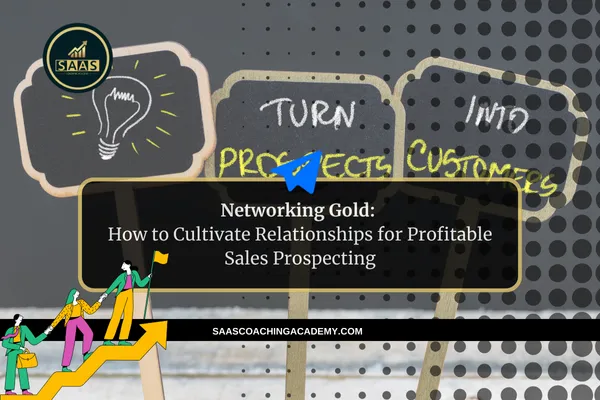Exciting Insights and Tips on Digital Marketing, Sales, Hustle Life, Customer Service, and Upcoming AI

Networking Gold: How to Cultivate Relationships for Profitable Sales Prospecting
Understanding the Fundamentals of Sales Prospecting
Sales prospecting is the lifeblood of any successful sales strategy. It is the process of identifying potential customers, or leads, and initiating contact with them to ultimately convert them into paying clients. In order to excel in sales prospecting, it is crucial to have a solid understanding of the basics and lay a strong foundation for your approach.
Defining prospecting is the first step in this process. It involves actively seeking out and engaging with potential customers who have shown interest in your product or service. By identifying these leads, you can focus your efforts on those who are most likely to convert, saving time and resources in the long run.
Identifying the target market is another key aspect of successful sales prospecting. By understanding the demographics, needs, and pain points of your ideal customers, you can tailor your approach to resonate with them effectively. This targeted approach increases the likelihood of making a meaningful connection and ultimately closing the deal.
Setting clear objectives for the prospecting process is essential for staying focused and motivated. By defining specific goals, such as the number of leads to reach out to or the conversion rate to aim for, you can track your progress and adjust your strategy as needed. This clarity of purpose helps to keep you on track and maintain momentum in your prospecting efforts.
Conducting thorough research is a fundamental aspect of successful sales prospecting. By gathering valuable insights about potential leads, such as their industry, pain points, and buying behavior, you can tailor your sales approach to address their specific needs effectively. This personalized approach increases the likelihood of making a meaningful connection and ultimately closing the deal.
In summary, understanding the fundamentals of sales prospecting is essential for laying the groundwork for success. By defining prospecting, identifying the target market, setting clear objectives, and conducting thorough research, you can position yourself for effective prospecting and ultimately drive conversions. This section sets the tone for the subsequent parts of the blog post, providing a solid foundation for readers to build upon as they delve deeper into the art of sales prospecting.

Crafting Compelling Pitches and Personalizing Your Approach
Now that we have established the fundamentals of sales prospecting in the previous section, it is time to delve into the art of crafting compelling pitches that resonate with potential clients. One of the key aspects of successful sales prospecting is the ability to personalize your approach and tailor your messages to address the specific needs and pain points of each lead.
When crafting your pitches, it is essential to grab the attention of your potential clients from the very beginning. Start by establishing credibility and building rapport with them. Show that you understand their challenges and can provide valuable solutions. By demonstrating empathy and expertise, you can create a connection that paves the way for a meaningful conversation.
Personalization is the key to making your pitches stand out in a sea of generic messages. Take the time to research your leads and gather insights about their industry, preferences, and buying behavior. Use this information to customize your pitch and show them that you have taken the time to understand their unique needs. This personalized approach not only increases the likelihood of capturing their interest but also sets the stage for a more productive conversation.
In addition to personalization, it is important to focus on the value proposition of your product or service. Clearly communicate the benefits and advantages that your offering brings to the table. Highlight how it can solve their problems, improve their processes, or help them achieve their goals. By showcasing the value that you can deliver, you can make a compelling case for why they should choose to do business with you.
In summary, crafting compelling pitches and personalizing your approach are essential steps in the sales prospecting process. By tailoring your messages to address the specific needs of your leads, demonstrating credibility, and emphasizing the value of your offering, you can create impactful pitches that resonate with potential clients and ultimately drive conversions. Stay tuned for the next section, where we will explore how to leverage technology and tools to streamline your prospecting efforts and maximize efficiency.


Leveraging Technology and Tools for Efficient Prospecting
As we continue our exploration of sales prospecting, it is crucial to understand the role that technology and tools play in optimizing the prospecting process. In today's digital age, sales professionals have access to a wide range of tools and software that can streamline tasks, track leads, and enhance efficiency. By leveraging these resources effectively, you can maximize your prospecting efforts and drive better results.
One of the key tools that sales professionals can utilize is customer relationship management (CRM) software. CRM systems are designed to help organize prospect data, track interactions, and nurture relationships with leads. By centralizing all relevant information in one place, you can gain valuable insights into your prospects' behavior and preferences, allowing you to tailor your approach more effectively. Additionally, CRM systems enable you to automate routine tasks, such as sending follow-up emails or scheduling appointments, freeing up your time to focus on building relationships and closing deals.
Another valuable tool for efficient prospecting is sales automation software. These tools are designed to streamline repetitive tasks, such as lead generation, outreach, and follow-up, allowing you to reach a larger number of prospects in less time. By automating these processes, you can increase your productivity, maintain consistency in your outreach efforts, and ensure that no lead falls through the cracks. Additionally, sales automation software often includes analytics and reporting features that provide valuable insights into the effectiveness of your prospecting campaigns, allowing you to make data-driven decisions and optimize your strategy for better results.
In addition to CRM and sales automation software, there are a variety of other tools and technologies that can enhance your prospecting efforts. For example, social media platforms can be powerful tools for connecting with potential leads, building relationships, and showcasing your expertise. Email marketing tools can help you create personalized and engaging email campaigns that resonate with your target audience. And data analytics tools can provide valuable insights into your prospecting performance, allowing you to identify trends, track key metrics, and make informed decisions to drive success.
In summary, leveraging technology and tools is essential for maximizing efficiency and effectiveness in sales prospecting. By utilizing CRM systems, sales automation software, and other tools, you can streamline tasks, track leads, and optimize your outreach efforts for better results. Stay tuned for the next section, where we will delve into overcoming common challenges in sales prospecting and provide practical strategies for navigating obstacles with confidence and resilience.

Overcoming Common Challenges in Sales Prospecting
In the world of sales prospecting, challenges are bound to arise. From facing rejection to managing time effectively, sales professionals must navigate a variety of obstacles to achieve success. In this section, we will explore some of the common challenges that sales professionals may encounter and provide practical strategies for overcoming them with confidence and resilience.
1. Dealing with Rejection: Rejection is a natural part of the sales process, but it can be disheartening for even the most experienced sales professionals. To overcome rejection, it is essential to maintain a positive mindset and view each rejection as an opportunity to learn and improve. By seeking feedback from prospects, analyzing what went wrong, and making adjustments to your approach, you can turn rejection into a valuable learning experience that ultimately strengthens your prospecting skills.
2. Handling Objections: Objections are a common hurdle in sales prospecting, but they can also be viewed as an opportunity to engage with prospects and address their concerns. When faced with objections, it is important to listen actively, empathize with the prospect's perspective, and respond with confidence and clarity. By anticipating common objections and preparing thoughtful responses in advance, you can navigate objections smoothly and build trust with your prospects.
3. Managing Time Effectively: Time management is crucial in sales prospecting, as it can be easy to get overwhelmed by the volume of leads and tasks to juggle. To manage your time effectively, prioritize your tasks based on their importance and urgency, set clear goals and deadlines, and eliminate distractions that may hinder your productivity. By creating a structured schedule and sticking to it, you can maximize your efficiency and focus on high-priority activities that drive results.
4. Staying Motivated: Sales prospecting can be a challenging and demanding endeavor, requiring resilience and perseverance to overcome setbacks and rejections. To stay motivated, it is important to set realistic goals, celebrate small wins, and maintain a positive attitude even in the face of adversity. Surrounding yourself with a supportive network of colleagues, mentors, or peers can also provide encouragement and motivation to keep pushing forward towards your goals.
In summary, overcoming common challenges in sales prospecting requires a combination of resilience, adaptability, and strategic thinking. By recognizing and addressing these challenges proactively, sales professionals can enhance their prospecting skills, build confidence, and achieve unparalleled success in their sales efforts. Stay tuned for the final section, where we will explore advanced techniques for closing deals like a seasoned pro and taking your sales prospecting to the next level.

Closing Deals Like a Seasoned Pro and Achieving Unparalleled Success
As we reach the final section of our exploration into the art of sales prospecting, we have covered a wide range of topics, from understanding the fundamentals to crafting compelling pitches, leveraging technology, and overcoming common challenges. Now, it is time to bring everything together and focus on closing deals like a seasoned professional to achieve unparalleled success in your sales efforts.
Closing deals is the ultimate goal of sales prospecting, and mastering this skill is essential for driving conversions and building lasting client relationships. By applying the knowledge and strategies outlined in the previous sections, you can elevate your performance and propel your success to new heights. Here are some key points to keep in mind as you strive to close deals like a seasoned pro:
1. Build Trust and Rapport: Establishing trust and rapport with your prospects is crucial for closing deals successfully. By demonstrating empathy, understanding their needs, and showcasing your expertise, you can create a strong connection that lays the foundation for a successful partnership.
2. Handle Objections with Confidence: Objections are a natural part of the sales process, but how you handle them can make all the difference. Anticipate common objections, prepare thoughtful responses, and address concerns with confidence and clarity. By showing that you can overcome objections effectively, you can build trust and credibility with your prospects.
3. Negotiate Effectively: Negotiation is a key skill in closing deals, as it allows you to find common ground and reach mutually beneficial agreements. Understand the needs and priorities of both parties, be flexible in your approach, and focus on creating value for your prospects. By negotiating with a win-win mindset, you can close deals more effectively and build strong relationships with your clients.
4. Seal the Deal with Confidence: When it comes time to seal the deal, approach the closing process with confidence and professionalism. Clearly communicate the terms of the agreement, address any final concerns or questions, and guide your prospects through the final steps to secure their commitment. By exuding confidence and competence, you can instill trust and assurance in your prospects, making it more likely for them to finalize the deal.
In conclusion, closing deals like a seasoned pro is the culmination of mastering the art of sales prospecting. By applying the knowledge, skills, and strategies outlined throughout this blog post, you can elevate your performance, build strong client relationships, and achieve unparalleled success in your sales efforts. Remember to stay focused, stay resilient, and always strive for excellence in every interaction. With dedication and perseverance, you can reach new heights in your sales prospecting journey. Good luck!



© 2025 SaaS Coaching Academy | All Rights Reserved | All Sales Are Final No Refunds | Privacy Policy | Terms of Service | Contact Us
info@leadstoroi.com
541-270-3477

